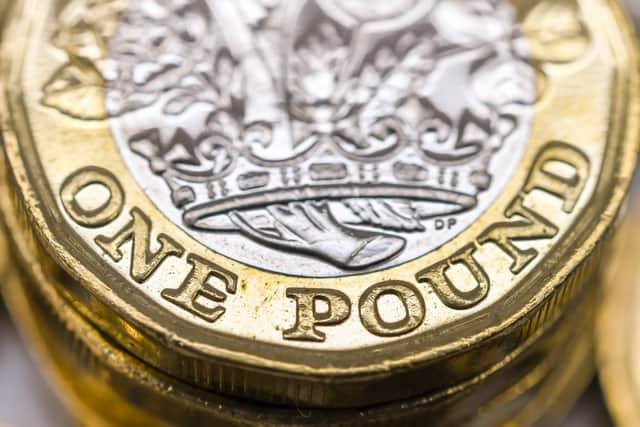Are pension funds at risk? Bank of England bonds intervention explained - can you protect your money?
and live on Freeview channel 276
Liz Truss and Kwasi Kwarteng’s mini budget was intended to be a fiscal event that would banish concerns about a UK recession and deliver prosperity that would trickle down into people’s pockets, tackling to cost of living crisis in the process.
But the swathe of unfunded tax cuts the Chancellor introduced, the lack of an independent assessment of what their economic impact would be, and the market’s dim view of the package has only served to undermine the Truss government and create economic uncertainty.
Advertisement
Hide AdAdvertisement
Hide AdAt the same time as questions abound over how long the Prime Minister will remain in power, the pound has struggled against the dollar and mortgage rates have soared. The Bank of England has warned worse is likely to come.


One of the unintended consequences of the mini budget was the impact its implied public borrowing spree would have on pension funds. The UK’s central bank was forced to prop up bond markets (bonds being the way in which the government borrows money) in the aftermath of Kwasi Kwarteng’s budget.
This £65 billion support package is now set to come to an end - something that has spooked the markets yet again.
But why exactly are pension funds at risk - and is there anything you can do to protect your money? Here’s everything you need to know.
What are pension funds?
Advertisement
Hide AdAdvertisement
Hide AdA pension fund is a financial institution that pools money people go on to use to fund their retirements. In essence, they are the private sector equivalents of sovereign wealth funds.
Pension funds invest the money they hold in a bid to maintain and, ideally, grow the cashpots they sit on. They have nothing to do with state pensions, which are paid for through tax contributions.


There are two different types of pension which tend to feed into pension fund pots - ‘defined contribution’ and ‘defined benefit’ pensions.
- Defined contribution pensions
These pots are based on how much money is paid into them. They are either arranged by your employer, or - if you’re self-employed - by yourself.
Advertisement
Hide AdAdvertisement
Hide AdWhat you pay in is invested, with the size of your retirement pot dependent on how much you’ve put into them, how well these investments have performed, and how you withdraw it. Pension funds typically take a small percentage out of your pot as a management fee.
- Defined benefit pensions
Sometimes known as ‘final salary’ or ‘career average’ schemes, these pensions are usually arranged by your employer. What you get depends on things like your salary, how long you’ve worked for the company, and what the fund’s rules are. For example, you may not be able to take your pension until you reach a certain age.
Where do pension funds invest money?
Pension funds invest money in several different ways. In the UK, most investments usually come in the form of shares and government bonds.
Government bonds - also known as gilts - tend to be popular investments for funds because they provide a predictable income stream (typically once or twice a year) and the UK government has traditionally held a good credit rating, making its debt a low-risk investment.


Advertisement
Hide AdAdvertisement
Hide AdFor funds specialising in defined benefit pension schemes, government bonds are also helpful because many of them last for a 20 to 30 year period. This longevity tends to allow the funds to match their assets with their liabilities.
Put simply, the money (assets) invested in these bonds usually grows at a rate that will allow the fund to pay out cash to pensioners at the rate they were promised (liabilities).
Liabilities can grow if those expecting a pension are on large incomes and live to an old age. Inflation and interest rates also have a bearing on the size of liabilities. The former grows liabilities, while the latter makes them smaller.
Why did Bank of England intervene?
The Bank of England was forced to step in to prop up the bonds market after the mini budget. The fall in the pound, fears over interest rate rises and concerns about how much money the government would need to borrow to fund its tax cuts almost led to a run on pension funds.


Advertisement
Hide AdAdvertisement
Hide AdDefined benefit pension funds were at the centre of the storm, particularly those using what are called Liability Driven Investments (LDIs).
Put very simply, these are insurance policies against changing liabilities. In more usual times, these allow pension funds to magnify their assets and free up cash for extra investments in exchange for a small amount of money that typically goes to banks. The money they have to put up grows with interest rates.
Explaining why LDIs have become an issue, Sarah Coles, a senior personal finance analyst at asset management company Hargreaves Lansdown, told NationalWorld: “As interest rates have risen [in 2022], [funds] have already had to put up more cash. But they increased slowly enough to give them time to sell other assets sensibly to cover it.
“The overnight collapse of bond values gave them no time. They were forced to sell bonds to cover the extra cost, depressing the price of bonds even more and creating a vicious circle.”
Advertisement
Hide AdAdvertisement
Hide AdWhat the Bank of England did when it intervened to stop this downward spiral was to offer itself up as a buyer for longer-term government bonds. By doing so it stabilised bond yields, which were growing as the markets began to price in interest rate hikes, and gave pension funds a better price for their bonds.
However, the rub was that it said this support would only be in place until Friday (14 October). When Bank of England governor Andrew Bailey said there would be no extension to this deadline, he was basically telling pension funds that they had only a short time left to sell up the bonds they needed to dispose of.


Pension funds had hoped the deadline would be extended until Kwasi Kwarteng’s Halloween fiscal statement, with the Chancellor due to set out the government’s medium-term economic plans.
Markets are hoping he will u-turn on the bulk of his tax cutting measures given Liz Truss has ruled out public spending cuts. They also hope the UK economic outlook - as judged by the Office for Budget Responsibility (OBR) - will not be as bad as they fear. Neither scenario is a given.
Advertisement
Hide AdAdvertisement
Hide AdThe fear is that the withdrawal of the Bank of England support will come too soon for the pension funds that have not managed to shift the required amount of bonds. It could mean the spiral of high yields and low prices starts again, which might put some pension funds’ solvency (i.e. their ability to pay out to pensioners) at risk.
With the deadline fast approaching and Andrew Bailey appearing to shut down any possibility of an extension, yields on 30-year bonds jumped to 20-year highs on Wednesday (12 October) according to trading platform Tradeweb.
Do you need to do anything to protect your pension?
This uncertain situation has led to anxiety that people, particularly those on defined benefit schemes, could find their pension pots wiped out. However, Sarah Coles sought to provide reassurance this would not be the case.
“People who are members of defined benefit pension schemes do not need to worry – this is a problem for your employer to resolve, not you,” she told NationalWorld.
Advertisement
Hide AdAdvertisement
Hide Ad“In defined benefit schemes it is the employer who is ultimately responsible to make up any shortfall in the funding of the scheme. However, this issue acts as a good prompt for you to review your retirement savings.”
Coles advised that those with a defined contribution pot also need not lift a finger. However, she advised that they check how their money is doing - particularly if they are getting closer to retirement.
Comment Guidelines
National World encourages reader discussion on our stories. User feedback, insights and back-and-forth exchanges add a rich layer of context to reporting. Please review our Community Guidelines before commenting.
